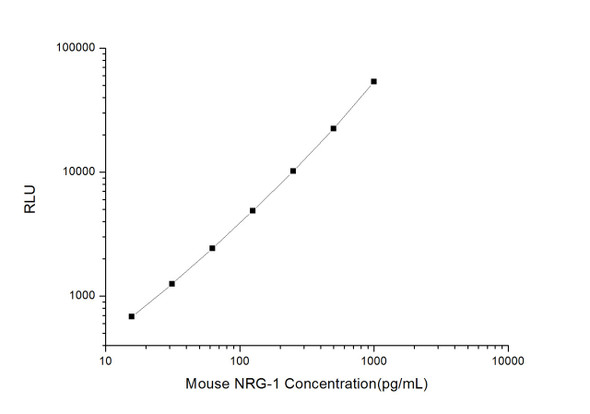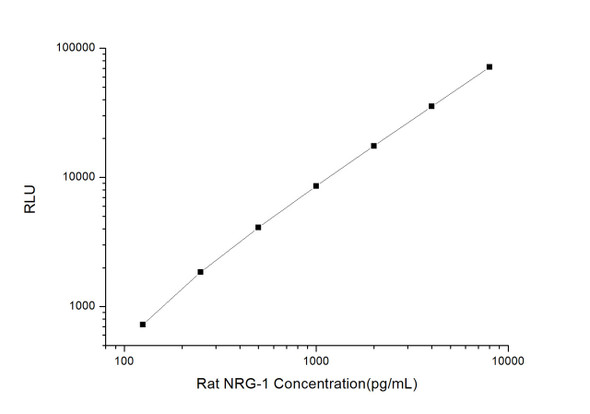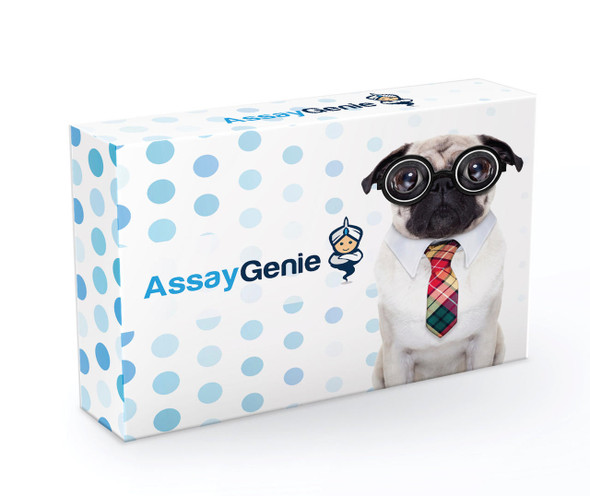Human Cell Biology ELISA Kits 5
Human NRG-1 (Neuregulin 1) CLIA Kit (HUES01041)
- SKU:
- HUES01041
- Product Type:
- ELISA Kit
- ELISA Type:
- CLIA Kit
- Size:
- 96 Assays
- Sensitivity:
- 18.75pg/mL
- Range:
- 31.25-2000pg/mL
- ELISA Type:
- Sandwich
- Synonyms:
- NRG1, ARIA, GGF, GGF2, HGL, HRG, HRG1, HRGA, MST131, NDF, SMDF
- Reactivity:
- Human
- Sample Type:
- Serum, plasma and other biological fluids
- Research Area:
- Cell Biology
Description
| Assay type: | Sandwich |
| Format: | 96T |
| Assay time: | 4.5h |
| Reactivity: | Human |
| Detection method: | Chemiluminescence |
| Detection range: | 31.25-2000 pg/mL |
| Sensitivity: | 18.75 pg/mL |
| Sample volume: | 100µL |
| Sample type: | Serum, plasma and other biological fluids |
| Repeatability: | CV < 15% |
| Specificity: | This kit recognizes Human NRG-1 in samples. No significant cross-reactivity or interference between Human NRG-1 and analogues was observed. |
This kit uses Sandwich-CLIA as the method. The micro CLIA plate provided in this kit has been pre-coated with an antibody specific to Human NRG-1. Standards or samples are added to the appropriate micro CLIA plate wells and combined with the specific antibody. Then a biotinylated detection antibody specific for Human NRG-1 and Avidin-Horseradish Peroxidase (HRP) conjugate are added to each micro plate well successively and incubated. Free components are washed away. The substrate solution is added to each well. Only those wells that contain Human NRG-1, biotinylated detection antibody and Avidin-HRP conjugate will appear fluorescence. The Relative light unit (RLU) value is measured spectrophotometrically by the Chemiluminescence immunoassay analyzer. The RLU value is positively associated with the concentration of Human NRG-1. The concentration of Human NRG-1 in the samples can be calculated by comparing the RLU of the samples to the standard curve.
| UniProt Protein Function: | NRG1: Direct ligand for ERBB3 and ERBB4 tyrosine kinase receptors. Concomitantly recruits ERBB1 and ERBB2 coreceptors, resulting in ligand-stimulated tyrosine phosphorylation and activation of the ERBB receptors. The multiple isoforms perform diverse functions such as inducing growth and differentiation of epithelial, glial, neuronal, and skeletal muscle cells; inducing expression of acetylcholine receptor in synaptic vesicles during the formation of the neuromuscular junction; stimulating lobuloalveolar budding and milk production in the mammary gland and inducing differentiation of mammary tumor cells; stimulating Schwann cell proliferation; implication in the development of the myocardium such as trabeculation of the developing heart. Isoform 10 may play a role in motor and sensory neuron development. The cytoplasmic domain interacts with the LIM domain region of LIMK1. Interacts with ERBB3 and ERBB4. Type I isoforms are the predominant forms expressed in the endocardium. Isoform alpha is expressed in breast, ovary, testis, prostate, heart, skeletal muscle, lung, placenta liver, kidney, salivary gland, small intestine and brain, but not in uterus, stomach, pancreas, and spleen. Isoform 3 is the predominant form in mesenchymal cells and in non-neuronal organs, whereas isoform 6 is the major neuronal form. Isoform 8 is expressed in spinal cord and brain. Isoform 9 is the major form in skeletal muscle cells; in the nervous system it is expressed in spinal cord and brain. Also detected in adult heart, placenta, lung, liver, kidney, and pancreas. Isoform 10 is expressed in nervous system: spinal cord motor neurons, dorsal root ganglion neurons, and brain. Predominant isoform expressed in sensory and motor neurons. Not detected in adult heart, placenta, lung, liver, skeletal muscle, kidney, and pancreas. Not expressed in fetal lung, liver and kidney. Type IV isoforms are brain-specific. Belongs to the neuregulin family. 10 isoforms of the human protein are produced by alternative splicing. |
| UniProt Protein Details: | Protein type:Cell development/differentiation; Membrane protein, integral; Ligand, receptor tyrosine kinase; Cytokine; Motility/polarity/chemotaxis Chromosomal Location of Human Ortholog: 8p12 Cellular Component: extracellular space; membrane; axon; integral to plasma membrane; apical plasma membrane; cytoplasm; extracellular region; neuromuscular junction; nucleus Molecular Function:ErbB-2 class receptor binding; protein binding; transmembrane receptor protein tyrosine kinase activator activity; growth factor activity; ErbB-3 class receptor binding; cytokine activity; transcription cofactor activity; protein tyrosine kinase activator activity; receptor tyrosine kinase binding; receptor binding Biological Process: regulation of protein heterodimerization activity; transmembrane receptor protein tyrosine kinase activation (dimerization); positive regulation of cell adhesion; neural crest cell development; wound healing; nerve growth factor receptor signaling pathway; cellular protein complex disassembly; cell morphogenesis; ventricular cardiac muscle cell differentiation; locomotory behavior; positive regulation of striated muscle cell differentiation; cardiac muscle cell differentiation; synaptogenesis; mammary gland development; cell communication; positive regulation of cardiac muscle cell proliferation; epidermal growth factor receptor signaling pathway; nervous system development; cell migration; phosphoinositide-mediated signaling; fibroblast growth factor receptor signaling pathway; neurotransmitter receptor metabolic process; regulation of protein homodimerization activity; MAPKKK cascade; neuron fate commitment; positive regulation of cell growth; peripheral nervous system development; positive regulation of protein kinase B signaling cascade; cell proliferation; embryonic development; glial cell fate commitment; innate immune response; negative regulation of secretion; positive regulation of Ras protein signal transduction; negative regulation of protein catabolic process; negative regulation of transcription, DNA-dependent; transmembrane receptor protein tyrosine kinase signaling pathway Disease: Schizophrenia 6 |
| NCBI Summary: | The protein encoded by this gene is a membrane glycoprotein that that mediates cell-cell signaling and plays a critical role in the growth and development of multiple organ systems. An extraordinary variety of different isoforms are produced from this gene through alternative promoter usage and splicing. These isoforms are expressed in a tissue-specific manner and differ significantly in their structure, and are classified as types I, II, III, IV, V and VI. Dysregulation of this gene has been linked to diseases such as cancer, schizophrenia, and bipolar disorder (BPD). [provided by RefSeq, Jun 2014] |
| UniProt Code: | Q02297 |
| NCBI GenInfo Identifier: | 9297018 |
| NCBI Gene ID: | 3084 |
| NCBI Accession: | Q02297. 3 |
| UniProt Secondary Accession: | Q02297,O14667, P98202, Q02298, Q02299, Q07110, Q07111 A5YAK4, A5YAK5, A8K1L2, B7Z4Z3, E9PHH4, |
| UniProt Related Accession: | Q02297 |
| Molecular Weight: | |
| NCBI Full Name: | Pro-neuregulin-1, membrane-bound isoform |
| NCBI Synonym Full Names: | neuregulin 1 |
| NCBI Official Symbol: | NRG1 |
| NCBI Official Synonym Symbols: | GGF; HGL; HRG; NDF; ARIA; GGF2; HRG1; HRGA; SMDF; MST131; MSTP131; NRG1-IT2 |
| NCBI Protein Information: | pro-neuregulin-1, membrane-bound isoform; pro-NRG1; glial growth factor; neu differentiation factor; sensory and motor neuron derived factor; heregulin, alpha (45kD, ERBB2 p185-activator) |
| UniProt Protein Name: | Pro-neuregulin-1, membrane-bound isoform |
| UniProt Synonym Protein Names: | Acetylcholine receptor-inducing activity; ARIA; Breast cancer cell differentiation factor p45; Glial growth factor; Heregulin; HRG; Neu differentiation factor; Sensory and motor neuron-derived factor |
| Protein Family: | Pro-neuregulin |
| UniProt Gene Name: | NRG1 |
| UniProt Entry Name: | NRG1_HUMAN |
As the RLU values of the standard curve may vary according to the conditions of the actual assay performance (e. g. operator, pipetting technique, washing technique or temperature effects), the operator should establish a standard curve for each test. Typical standard curve and data is provided below for reference only.
| Concentration (pg/mL) | RLU | Average | Corrected |
| 2000 | 51536 59906 | 55721 | 55693 |
| 1000 | 22855 25093 | 23974 | 23946 |
| 500 | 11432 10632 | 11032 | 11004 |
| 250 | 5214 5374 | 5294 | 5266 |
| 125 | 2786 2430 | 2608 | 2580 |
| 62.5 | 1370 1252 | 1311 | 1283 |
| 31.25 | 643 705 | 674 | 646 |
| 0 | 27 29 | 28 | -- |
Precision
Intra-assay Precision (Precision within an assay): 3 samples with low, mid range and high level Human NRG-1 were tested 20 times on one plate, respectively.
Inter-assay Precision (Precision between assays): 3 samples with low, mid range and high level Human NRG-1 were tested on 3 different plates, 20 replicates in each plate.
| Intra-assay Precision | Inter-assay Precision | |||||
| Sample | 1 | 2 | 3 | 1 | 2 | 3 |
| n | 20 | 20 | 20 | 20 | 20 | 20 |
| Mean (pg/mL) | 94.05 | 218.77 | 834.79 | 87.98 | 199.80 | 768.90 |
| Standard deviation | 10.40 | 16.63 | 52.09 | 8.09 | 17.70 | 78.20 |
| C V (%) | 11.06 | 7.60 | 6.24 | 9.20 | 8.86 | 10.17 |
Recovery
The recovery of Human NRG-1 spiked at three different levels in samples throughout the range of the assay was evaluated in various matrices.
| Sample Type | Range (%) | Average Recovery (%) |
| Serum (n=5) | 96-112 | 103 |
| EDTA plasma (n=5) | 97-114 | 104 |
| Cell culture media (n=5) | 89-102 | 96 |
Linearity
Samples were spiked with high concentrations of Human NRG-1 and diluted with Reference Standard & Sample Diluent to produce samples with values within the range of the assay.
| Serum (n=5) | EDTA plasma (n=5) | Cell culture media (n=5) | ||
| 1:2 | Range (%) | 97-109 | 99-114 | 92-108 |
| Average (%) | 102 | 104 | 99 | |
| 1:4 | Range (%) | 98-114 | 94-106 | 88-98 |
| Average (%) | 105 | 100 | 93 | |
| 1:8 | Range (%) | 90-102 | 84-98 | 102-117 |
| Average (%) | 95 | 91 | 108 | |
| 1:16 | Range (%) | 91-104 | 101-114 | 90-105 |
| Average (%) | 97 | 108 | 98 |
An unopened kit can be stored at 4°C for 1 month. If the kit is not used within 1 month, store the items separately according to the following conditions once the kit is received.
| Item | Specifications | Storage |
| Micro CLIA Plate(Dismountable) | 8 wells ×12 strips | -20°C, 6 months |
| Reference Standard | 2 vials | |
| Concentrated Biotinylated Detection Ab (100×) | 1 vial, 120 µL | |
| Concentrated HRP Conjugate (100×) | 1 vial, 120 µL | -20°C(shading light), 6 months |
| Reference Standard & Sample Diluent | 1 vial, 20 mL | 4°C, 6 months |
| Biotinylated Detection Ab Diluent | 1 vial, 14 mL | |
| HRP Conjugate Diluent | 1 vial, 14 mL | |
| Concentrated Wash Buffer (25×) | 1 vial, 30 mL | |
| Substrate Reagent A | 1 vial, 5 mL | 4°C (shading light) |
| Substrate Reagent B | 1 vial, 5 mL | 4°C (shading light) |
| Plate Sealer | 5 pieces | |
| Product Description | 1 copy | |
| Certificate of Analysis | 1 copy |
- Set standard, test sample and control (zero) wells on the pre-coated plate and record theirpositions. It is recommended to measure each standard and sample in duplicate. Note: addall solutions to the bottom of the plate wells while avoiding contact with the well walls. Ensuresolutions do not foam when adding to the wells.
- Aliquot 100 µL of standard solutions into the standard wells.
- Add 100 µL of Sample / Standard dilution buffer into the control (zero) well.
- Add 100 µL of properly diluted sample (serum, plasma, tissue homogenates and otherbiological fluids. ) into test sample wells.
- Cover the plate with the sealer provided in the kit and incubate for 90 min at 37 °C.
- Aspirate the liquid from each well, do not wash. Immediately add 100 µL of BiotinylatedDetection Ab working solution to each well. Cover the plate with a plate seal and gently mix. Incubate for 1 hour at 37 °C.
- Aspirate or decant the solution from the plate and add 350 µL of wash buffer to each welland incubate for 1-2 minutes at room temperature. Aspirate the solution from each well andclap the plate on absorbent filter paper to dry. Repeat this process 3 times. Note: a microplatewasher can be used in this step and other wash steps.
- Add 100 µL of HRP Conjugate working solution to each well. Cover with a plate seal andincubate for 30 min at 37 °C.
- Aspirate or decant the solution from each well. Repeat the wash process for five times asconducted in step 7.
- Add 100 µL of Substrate mixture solution to each well. Cover with a new plate seal andincubate for no more than 5 min at 37 °C. Protect the plate from light.
- Determine the RLU value of each well immediately.






